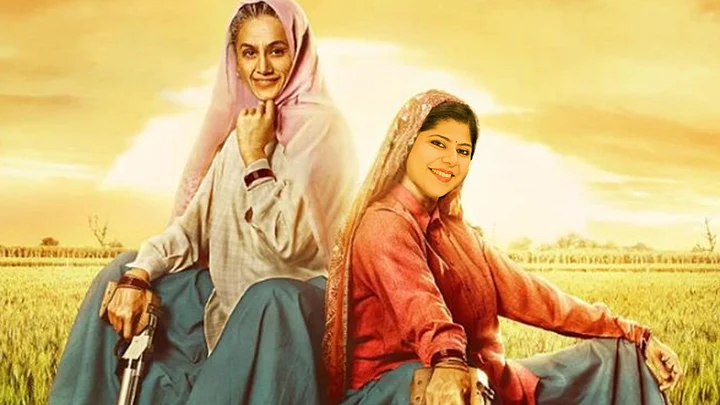Saand ki Aankh literally translates to “bull’s eye”, and this comes naturally to Chandro and Prakashi Tomar. Having discovered their flair for shooting and hitting the bull’s eye well past their prime, these dupatta-clad grandmothers earned themselves the sobriquet of “shooter daadis”!
Debutant director Tushar Hiranandani’s film Saand ki Aankh draws inspiration from their lives. The film begins in the year 1999. It’s in the Johri village Bagpat that we first meet the spirited women. In hushed tones and shared moments of joy they somehow manage to create a safe zone in the minefield of archaic rules that the resident patriarch shoves down their throats . The women must cover their heads with ghunghat (veil). So much so that the women are identified actually by the colour of their dupattas. They can’t leave the house without a male companion. The only thing that awaits them is marriage and pati ki seva (taking care of the husband). It’s therefore nothing short of a miracle when the Tomar women find a way to escape their dreadful circumstances by engaging in the sport of shooting. Chandro and Prakashi, covered as their are in their bright dupattas and skirts, are unstoppable in the shooting range.

The only time Saand ki Aankh tugs at our heart strings and pulsates with genuine emotions is when Taapsee Pannu and Bhumi Pednekar are left to peddle their wares.
Once the fact that the women can take their aims with precision is established, Balwinder Singh Janjua‘s narrative refuses to budge . Several matches are shown where the sharpshooter daadis go and stun the naysayers, but they all follow the same trajectory and end up being repetitive. Unnecessary scenes involving songs add nothing to the storytelling, and if anything this truly inspiring real-life story looks contrived and fictional at places. The writing, in particular, is a huge letdown. Also, the non-existent editing leaves the film bloated and painfully long.
The only time Saand ki Aankh tugs at our heart strings and pulsates with genuine emotions is when Taapsee Pannu and Bhumi Pednekar are left to peddle their wares. They might have had to put in a lot of effort to “look “ their part thanks to prosthetics (which was another letdown) and carefully streaked salt-and-pepper hair (that was badly done ), but the two shine and put up a spectacular show that is powerful and evocative. Be it confronting Rattan Singh’s (masterfully played by Prakash Jha) atrocious ways or the quiet support and encouragement from their coach Dr Yashpal (Viineet Kumar singh), the scenes could have been executed beautifully had the writing not been so formulaic. Singh’s character is important but not utilised well.

The orthodox thinking and sexism does not vanish all of a sudden. It is slowly challenged. The daadis’ first struggle is to free themselves, and then they continue fighting for their daughters. But the film moves forward in the most tepid and convoluted manner. There are unnecessarily long sequences that are inconsequential. For instance the sequence where both Chandro and Prakashi are surprised when they are handed sunglasses or they meet a royal family from Rajasthan are stretched. The lack of nuance and the loud background score accompanying some of the rousing speeches dampen the overall impact.
Saand Ki Aankh could have been infinitely better if it had got rid of its pompous length.
The women don’t disappoint. Both Taapsee and Bhumi with their accent and body language hit the bull’s eye, but does the film manage to do so ? Not quite ! Saand Ki Aankh could have been infinitely better if it had got rid of its pompous length!
(At The Quint, we question everything. Play an active role in shaping our journalism by becoming a member today.)

